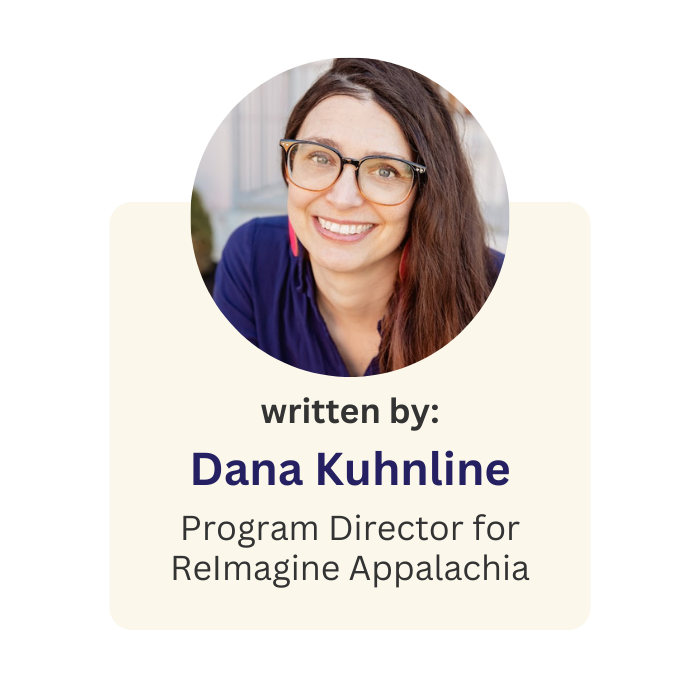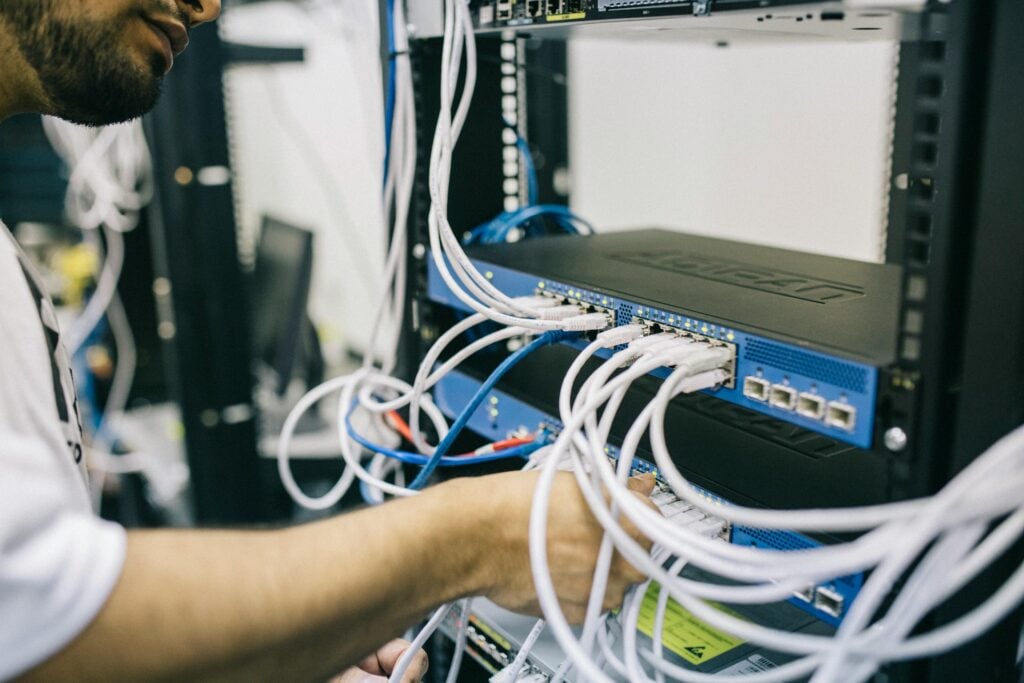
October 2, 2025
The conversation about data centers is everywhere these days – as it should be. The explosive growth of this industry, while inevitable in the wake of artificial intelligence, is changing our communities across many dimensions and deserves careful consideration.
Attracting new industries to our communities should not be a race to the bottom; the new growth of data centers in the region is a call to assess how our policy models have historically favored economic and project development that benefits extractive, exploitative, absentee corporations at the expense of our communities, workers and lands. But there is a better way.
We can do economic development differently – in a way that is good for workers, communities and the environment. Data centers–with their intense and growing need for electricity that is pressuring our outdated electrical system and energy prices, producing massive amounts of waste heat threatening to pollute our waterways and ecosystem further, and creating construction jobs but little need for more permanent jobs–all require a new approach if we don’t want to repeat industrial development mistakes of the past. In response, numerous stakeholder groups have published or are in the process of publishing issue and position papers offering more responsible approaches to data center development.
In this blog, in order to start a broader conversation around responsible data center development across diverse stakeholder groups, we’re going to summarize some of the conversations we’re hearing from across our coalition – and some of the resources our partners are making to enable communities to have a seat at the table in determining how this industry takes shape.
Where are data centers headed?
The DOE, through NREL, released a map of data center infrastructure by county across the nation. It includes information to help you find data centers that are currently operating, under construction or planned and also includes information on anticipated energy demand, transmission line infrastructure and more. Another map that may be useful comes from FracTracker, and uses publicly accessible data to paint a detailed picture of where data centers are being located.
Data centers use a lot of electricity – and create a lot of heat:
You’ve probably heard by now that data centers are major energy users – so much so that they are prompting a need for us to completely re-think the United States energy sector. According to new analysis from MIT Technology Review, AI data centers now consume 4.4% of all U.S. energy, with some projections showing AI alone could use as much electricity as 22% of U.S. households by 2028, other projections show up to up to 12% of total by 2028. These centers typically use electricity that’s 48% more carbon-intensive than the U.S. average electricity usage. This relates largely to the speed at which they are being built, since hastily built data centers don’t leave time to develop a corresponding renewable energy network.
While many are well aware of the amount of electricity data centers use, people often overlook the waste heat emissions and their impact. Data centers generate significant amounts of waste heat due to the high energy consumption of their servers and cooling systems. Instead of dissipating this heat into the environment, as is often done, it can be recovered and used for other purposes.

One opportunity to make data centers a better neighbor is to locate them on shuttered industrial facilities, such as former coal plants (rather than greenfields). Ideally, data centers at shuttered facilities would be co-located with factories or other entities like greenhouses that can benefit from data center waste heat. This reduces their reliance on traditional heating methods, supports energy efficiency and energy savings, and gives the shuttered facility a new purpose. Shuttered coal plants, and many former industrial sites, also have access to heavily reinforced electrical grid infrastructure (along with other reusable assets), reducing the need for on-site electrical system upgrades.
Waste heat recovery can significantly reduce the carbon footprint of both data centers and nearby facilities by minimizing energy consumption from traditional heating methods. For example, in Marietta, OH, an innovative pilot program will use the waste heat from a data center to heat a nearby greenhouse.
Overall, waste heat recovery can significantly reduce the carbon footprint of both data centers and nearby facilities by minimizing energy consumption from traditional heating methods. Forthcoming research from ReImagine Appalachia will go into more detail about the potential for waste heat to be used for heating buildings, community facilities, and agricultural operations and other strategies, as well as the policy frameworks needed to increase the adoption of waste heat capturing for economic and community benefits.
Appalachian manufacturers should be a part of the data center supply chain:
Components for data centers should be procured locally if at all possible, so that the creation of these components contributes to the region’s manufacturing sector. Our partners at Catalyst Connection recently published this report and a series of webinars on the potential for small and mid-sized manufacturers (SMMs) to integrate with this new supply chain.
Good policy can protect communities,workers and ecosystem:
Policy in our nation has been slow to catch up to the data center boom, however, advocates are working to create guidance to help our communities get up to speed.
Zoning ordinances: Our friends at PennFuture have created a series of videos showing considerations communities should keep in mind when a potential data center comes to town. They have also created a model zoning ordinance with suggested provisions addressing water consumption, power consumption, noise, and aesthetic concerns.
Community Input, Job Access and Labor Standards: While there are few jobs in completed data centers, we should ensure that any jobs created are good jobs and local workers have access to them. Data from Business Insider show that most data center jobs are in construction, and often contracted from outside the places the centers are located. Strong labor standards are key to ensure that local workers are hired in the development and construction of new sites. ReImagine Appalachia’s Economic, Community and Project Development Principles contain examples for strong labor standards during the construction of these sites. It is important to ensure policy includes issues such as prevailing wage, responsible bidder policies, project labor agreements, registered apprenticeship and the prevention of wage theft.
Principles for reform: In Virginia, which is home to the world’s highest concentration of data centers, the Piedmont Environmental Council and the Virginia Data Center Reform Coalition have drawn on their first hand experience to create four principles of data center reform. The principles include enhanced transparency for issues like energy use, water consumption and emissions from data centers, state oversight to evaluate the regional impacts of data centers, protections for families and businesses, to assess risks and costs associated with data centers and ensure that residents are shouldering those expenses, and incentives for efficiency. Data centers can use as much power as a small city; higher standards to use clean energy, energy efficiency, and practices like co-location should be encouraged to reduce the power load.
Environmental and Climate Justice Principles. Another set of guiding principles has recently been released by the NAACP; this set of principles follows a convening in Memphis, Tennessee of nearly 70 climate and community advocates, including those who have been engaged with community issues surrounding the South Memphis Data Center. One issue called for includes transparency and legally binding accountability for any commitments, such as those on water use, energy consumption, emissions, and tax breaks.
Mitigating Pressure on Energy Prices – Recommendations. A guide from the Natural Resources Defense Council (NRDC) includes policy recommendations to help mitigate the impacts that data center growth will have on our nation’s electrical grid; as well as on consumer’s electric bills. Common sense policies can help incentivize data centers to adhere to best practices and help our government to assess, plan, and build smarter energy systems with expanded and upgraded transmission infrastructure, battery storage, and renewables.
An innovative approach to meet data center energy demands comes from Rewiring America. They recommend data centers and other “hyperscalers” to pay for heat pumps, rooftop solar and other investments in local homes to offset their energy use. Instead of building a new power plant, we can reduce household’s use of the grid, improve the health and comfort of local residents, and reduce peak demand.
The importance of strong policy:
A survey of tax incentives found that 36 states have implemented tax breaks for data centers; some of which include requirements for community benefits, job creation requirements, and other standards to help ensure that communities have a seat at the table with new projects that come to their town.
However, many of these tax incentives do not include meaningful development standards, and some deliberately exclude communities from having a say in local development. One of the more troubling examples of data center policies comes from West Virginia. In May 2024, the Governor of WV signed HB 2014 into law; this bill removes local government control over issues like property taxes, zoning ordinances and more. This takes away an important source of local revenue, even as data centers increase the needs for public services that local governments provide. The goal of the bill is to make West Virginia the most welcoming state in the US for data centers, but it has instead left communities without oversight or input into new projects and at the mercy of bad actors.
Looking forward
We must move towards basic development standards designed to ensure projects truly benefit local workers and residents. New policies could help ensure that data centers pay fair electricity rates and taxes; build additive, new, local clean energy and transmission to be shared with communities; use sustainable water technologies; innovate in waste-heat practices, treat workers fairly, and contribute to the local tax base and deliver community-defined benefits.
If we combine forces to jointly develop a model responsible data center development policy position, maybe we can collectively put an end to the race to the bottom already in progress in places like West Virginia.
Who out there is on board to do data center development differently?
